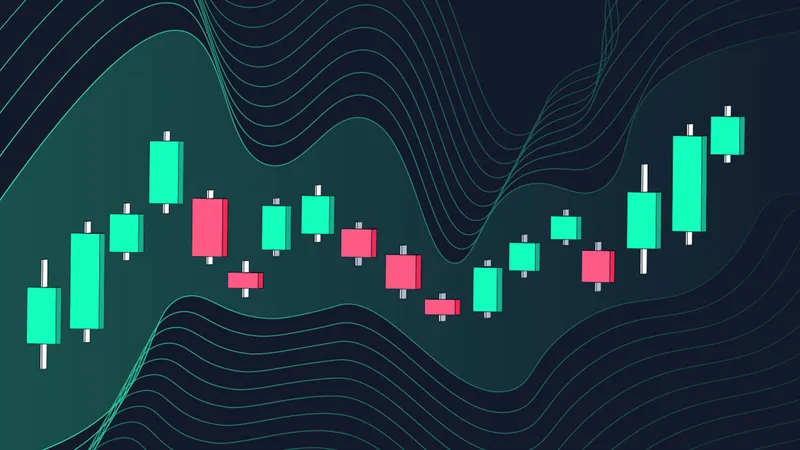近年、多くの人々が現在の不安定な時代におけるインフレ率の影響をある程度回避できる投資先を模索しています。金や米ドル、その他の安全資産に加え、仮想通貨もインフレ脱出の手段としてトレーダーの関心を集めています。しかし、仮想通貨取引には市場の高いボラティリティに起因する高リスクが伴います。
しかし、もし現在の市場のボラティリティについて洞察を得られる方法があったらどうでしょうか。それにより、特定の仮想通貨のボラティリティを測定し、エントリーおよびエグジットレベルを判断する助けになるかもしれません。
仮想通貨トレーダーは未来の価格動向を予測するためにさまざまな テクニカル分析 指標を利用しています。その中でも広く使われている人気のテクニカル指標の一つがボリンジャーバンドです。この指標は市場のボラティリティを処理し、可能なエントリー/エグジットレベルを定義し、市場のトレンドを分析するほか、仮想通貨の買われ過ぎや売られ過ぎの状態に関する情報を提供します。
では、ボリンジャーバンドは何ができるのか詳しく見てみましょう。その計算方法、読み方、そして仮想通貨取引におけるさまざまな戦略にどのように適用して取引機会を見極めるかを説明します。
ボリンジャーバンドとは?
アメリカの資産マネージャーでありテクニカルアナリストのジョン・ボリンジャー氏が1980年にこのテクニカル指標を設計し、自身の名前を冠しました。 ボリンジャーバンドは金融市場ではBBsと略されます。主に仮想通貨の価格の現在および過去のボラティリティや株式、商品、為替など他の金融資産を測定するために使用されます。
BBs指標は、3つのバンドで構成されています。これらのバンドはボラティリティ指標として機能し、特定の仮想通貨の直近の取引に基づく相対的な高低価格を定量化します。標準偏差でボラティリティを測定し、これはボラティリティに応じて変動します。価格が上昇するとバンド間のギャップが拡大し、価格が下落するとバンド間のギャップが縮小する傾向があります。
BBsは 上部、 中央、および 下部 の3つのバンドまたはラインで構成されています。中央のバンドは単純移動平均を表し、上部バンドと下部バンドは中央バンドからの2つの標準偏差を表します。簡単に言えば、BBsは定期的な基準に対する仮想通貨のボラティリティについて洞察を提供します。
KuCoinのチャートにボリンジャーバンド指標を適用する方法
以下は、ボリンジャーバンドを KuCoin取引所 のチャートに追加する方法です。
ステップ 1: 指標を選択
KuCoin取引チャート上部に表示されるオプションから指標を選択します。
ステップ 2: ボリンジャーバンドを検索
検索バーに「Bollinger Bands」と入力すると、検索リストにインジケーターの一覧が表示されます。
ステップ 3: テクニカル指標からボリンジャーバンドを選択
テクニカル指標のリストからボリンジャーバンドを選択すると、KuCoinチャート上に自動的に適用されます。
ボリンジャーバンドの構造
-
中央バンドはN期間の単純移動平均で構成されています。
-
上部バンドは、仮想通貨の価格の標準偏差を「K」倍したものを中央ラインの値に加えることで計算されます。
-
下部バンドは、仮想通貨の価格の標準偏差を「K」倍したものを中央ラインの値から引くことで計算されます。
ほとんどの場合、ボリンジャーバンドのパラメータはデフォルトでN = 20、K = 2に設定されていますが、トレーダーのニーズに応じてカスタマイズ可能です。ボリンジャーバンドのもう一つの興味深い特徴として、「K」の値を変更したり、SMAをEMAに置き換えたりすることが可能です。仮想通貨トレーダーがこの計算式をKuCoinの価格チャートに適用すると、価格はエンベロープまたはチャンネルのような形状を示します。以下のグラフにその例を示します。
上部線、中部線、下部線
上部線はSMA(単純移動平均)からの正の標準偏差を表し、下部線は負のSMAを表します。これらは青色で表示され、「上部バンド」と「下部バンド」と呼ばれます。一方、中部線は赤色で表示され、直近20期間のSMAを基にしています。これは、過去20期間またはローソク足の終値を足した後、名前が示すように20で割ったものです。
-
バンドはSMAの周辺にボラティリティが高い場合に広がり、ボラティリティが低い場合に収縮して狭くなります。
-
ボリンジャーバンドが示すもう1つの特徴としては、買われ過ぎ(オーバーボート)と売られ過ぎ(オーバーソールド)の領域です。価格がバンド内で新たな高値または安値を付け、それに続く新たな高値や安値がバンド外に出る場合、トレンドの反転の可能性があります。
-
仮想通貨価格が急騰すると、上部バンドを上回る場合があり、価格が下落する際には下部バンドを下回る場合があります。ただし、これは必ずしもトレンドの反転を意味するわけではありません。このような場合には、バンドがトレンド継続パターンを示すこともあります。
-
特定の仮想通貨の価格が上部バンドと下部バンドの間で変動し続ける場合、市場はレンジ相場にあると言われます。このようなレンジ相場では、価格のサポートレベルとレジスタンスレベルを定義することができます。
-
仮想通貨がトレンド相場にある場合、その価格はボリンジャーバンドの中部線を一貫して上回り、長期間にわたって上部バンドに達する傾向があります。
-
上部バンドと下部バンドが長期間にわたり互いに接近する場合、ブレイクアウトが予想されます。
ボリンジャーバンドを使用して継続パターンと反転シグナルを見極めるには経験が必要です。この経験は、練習とインジケーターの読み取りを通じてのみ得られます。
ボリンジャーバンドの設定
ボリンジャーバンドの設定は、トレーダーの取引スタイルに大きく依存します。以下は、さまざまなタイプのトレーダーに推奨される設定です:
デイトレーダー: 短期トレーダーには、ボリンジャーバンドのSMAを10期間、バンドを1.5SDに設定することが推奨されます。
スイングトレーダー: 中期トレーダーは、SMAを20期間に設定し、SDを2に設定することを推奨します。これらの設定は、多くのプラットフォームでのデフォルトのボリンジャーバンドのパラメータでもあります。
ポジショントレーダー: 長期トレーダーには、50 SMAをミドルバンドとして使用し、上部バンドおよび下部バンドには標準偏差設定を2.5に設定することが推奨されます。
暗号資産取引におけるボリンジャーバンドの活用方法
前述の通り、ボリンジャーバンドはさまざまな取引シグナルを見つけるために利用できます。ここでは、暗号資産取引において、どのようにボリンジャーバンドを活用して利益を得る取引機会を見つけるかを解説します。以下の方法を採用することで、トレーダーはボリンジャーバンドを有効活用できます。
ボリンジャーバウンス戦略
ボリンジャーバウンスは、ボリンジャーバンドを使用する最も基本的でシンプルな取引戦略です。この戦略を実行する際に従うべき簡単なルールは以下の通りです:
-
価格が下部バンドに触れた際に買い取引を実行し、価格が上部バンドに触れた際にはショートトレードまたは売り取引を実行します。
-
20移動平均線(MA)にトレーリングストップを設定し、移動平均線が変化するたびにその設定を変更します。
-
価格が20移動平均線に戻った際には、即座に市場から離れ、ポジションを閉じます。
例として、KuCoinの BTC/USDT 取引チャートを見てみましょう。BTC が上部ボリンジャーバンドを超えると、仮想通貨投資家はショートを開始します。
同様に、BTC価格が下部ボリンジャーバンドを突破した際には、強気派(ブル派)のトレーダーが市場に参入します。
これが、利益を上げるための基本的なボリンジャーバンド反発ルールです。しかし、この手法はそれだけでは完結しません。この戦略が有効となるのは、市場が横ばい(レンジ相場)で動いている場合、つまりバンドが長期間ほぼ平坦である場合に限られます。
一方で、市場がトレンド相場であったり、バンドが上向きまたは下向きのカーブに変化している場合、この戦略は大きな損失を招く可能性があります。そのため、トレンドがある市場ではボリンジャーバンド反発戦略を避け、トレンドのない市場でのみ使用するようにしてください。
ボリンジャーバンド・スクイーズ: 新しいトレンドを特定する
先述の通り、ボリンジャーバンドは新しいトレンドの始まりを特定するためにも使用できます。この戦略は、新しいトレンドのレベルを特定することを目的としています。
ルールは簡単です:
-
マーケットで継続的な低ボラティリティ期間を探します。低ボラティリティはバンドが狭まることで定義されます。
-
次に、バンドの外側で期間またはローソク足が終了するのを待ちます。このブレイクアウトはバンドの上方または下方で発生する可能性があります。
-
バンドが拡大し始めるタイミングでブレイクアウトが発生します。
-
これはトレンドの始まりです。このトレンドを特定した後、ブレイクアウト方向に取引を開始します。
-
価格が上部バンドを突破した場合、買い取引を開始できます。
-
価格が下部バンドを突破した場合、売り取引を開始できます。
WボトムとMトップの発見
仮想通貨の価格チャートで Wボトムや Mトップを見つけた後、取引を行う際にもボリンジャーバンドを活用することができます。これらのパターンは非常に簡単に見つけることができ、取引に役立ちます。
Wボトム
価格チャートで Wボトムのパターンを見つけるのは少し難しい場合があります。そのため、簡単なルールとして、ダブルボトムを探すことを推奨します。最初の下落するローソク足(キャンドルスティック)はボリンジャーバンドの外側で終わる必要があり、2回目の安値は常にボリンジャーバンドの内側で発生する必要があります。
上記の日足チャートに見られるように、ビットコインは Wボトム、またはダブルボトムのパターンを形成しています。仮想通貨の価格が2回目の安値から反発すると、反転が起こる可能性が高いと考えられます。トレーダーはここで買いポジションを市場に開くことができます。
Mトップ
仮想通貨の価格が高値に達した場合、Mトップはトレーダーに対し、パターンを探す信号を示します。この場合、最初の高値がボリンジャーバンドの外側で、2回目の高値がボリンジャーバンドの内側であることを確認する必要があります。
Bitcoinは、日足チャートでMトップまたはダブルトップと呼ばれるパターンを形成しています。このパターンを発見した場合、ショートポジションまたは売り取引を開始することが可能です。なぜなら、その後、チャートに示されている通り、トレンドが反転する可能性が高いからです。
最終的なポイント
ボリンジャーバンドは、優れた取引機会を特定するための重要なテクニカルインジケーターです。重要なのは、バンドの解釈を市場のトレンドに基づいて行うことです。バンドの挙動は、トレンド市場とレンジバウンド市場で異なる場合があります。ボリンジャーバンドは、単独で買われ過ぎまたは売られ過ぎゾーンを特定するために使用するべきではありません。
これらのシグナルを確認するためには、他のインジケーターの読み取り結果と組み合わせることを推奨します。特に RSI 、 ストキャスティクRSI 、または MACD インジケーターと組み合わせると効果的です。これらは、エントリーポイントとエグジットポイントを決定するために広く使用されています。経験豊富なトレーダーは、単一のインジケーターに依存せず、複数のインジケーターが確認された後にのみ取引を実行します。
